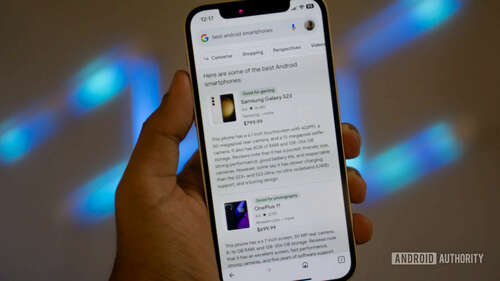
Edgar Cervantes / Android Authority
Although imperfect, generative AI tools like ChatGPT and Google’s Gemini are improving faster than many of us can keep up. However, this progress stands to threaten some of the most skilled jobs out there, including many tech industry-adjacent roles. Some would argue this transition has already kicked in, given the persistent rounds of layoffs that have resonated throughout 2023 and 2024. So on that somber note, let’s take a clear-eyed look at the specific tech jobs most likely to be disrupted by AI, and what skills will be essential in this evolving landscape.
Will AI replace tech jobs and which ones are at risk?
Contrary to popular belief, artificial intelligence isn’t going to replace all of us or our jobs overnight. History has proven that automation tends to create new opportunities rather than causing mass unemployment. More importantly, though, the AI of today often requires human intervention to correct obvious mistakes. All of this suggests that generative AI is more likely to augment existing jobs than replace them altogether.
If you’ve ever looked behind the scenes of a website or app’s development, you’ll know that much of the process involves repetitive tasks. Developers have to write dozens of lines of boilerplate code, sift through badly written documentation, and test their products under a variety of conditions. Each one of these tasks can become simpler with AI, while still requiring human input or supervision. Likewise, many tech roles demand skills in risk assessment, critical thinking, and decision-making — areas where current generative AI capabilities fall woefully short.
So with that in mind, here’s a list of tech jobs that AI could upend, and potentially replace, in the coming years.
1. Data entry and analysis

Robert Triggs / Android Authority
AI poses a significant threat to data entry and analysis roles, across nearly all skill levels. Case in point: even the most difficult and manual kind of data entry jobs that involve porting information from paper to a digital database can now be performed using a combination of optical character recognition (OCR) and natural language processing (NLP). While neither of those technologies is new, adding generative AI to the mix could help machines sort unorganized data as accurately as a human in a fraction of the time.
The same goes for data analysis as AI’s biggest strength is finding patterns and trends in large datasets. We’ve already seen how Google’s Gemini chatbot can export tables directly to Google Sheets, for example, which makes generating basic reports easier than ever. The silver lining is that AI won’t take over data scientists and complex analysis, so a beginner’s career trajectory will simply change rather than disappear overnight.
2. Software testing and quality assurance (QA)
Developers working on apps, games, and websites typically test their creations under real-world conditions and simulated human behavior. The worldwide software testing market amounts to a whopping $45 billion today, but many facets remain manual and human-dependent even today.
AI could automatically generate test cases based on a product’s intended audience and execute them several times faster than humans. This will allow developers up the chain to receive feedback much sooner and speed up the overall quality assurance process. We’ll still need human testers at various stages of product testing, but not as many as we do today.
3. Graphic design and artists

Calvin Wankhede / Android Authority
With AI-generated art making waves, it’s only a matter of time before it permeates through various forms of media. In fact, some would argue that AI has already crept into the entertainment industry. In late 2023, the hit video game The Finals stirred controversy for employing generative AI to produce dialogue. While the company employed voice actors, it also used text-to-speech for “contextual in-game actions”.
Graphic design is yet another field that’s in a moment of crisis because of AI. Midjourney is capable of converting plain English text into beautiful artwork. This allows a smaller group of designers to create and modify assets used in everything from blockbuster movies to video games. We also know that OpenAI is actively working on a text-to-video generator called Sora.
Finally, while professional photographers can make a living off selling stock images and videos on the internet today, that could change too. Meta trained its Imagine image generator on public photos from Facebook and Instagram. With the sheer breadth of real-world imagery available on social media platforms, it’s hardly surprising that Meta’s AI can generate photorealistic images within seconds.
4. Help desks and tech support

Ryan Haines / Android Authority
Most of us have encountered a tech support bot at some point, but communicating with one almost always feels like an exercise in frustration. These chatbots were once cutting-edge but now seem quaint in comparison to modern AI like ChatGPT. As language models become cheaper to deploy in the coming years, we’ll likely see the rollout of improved support chatbots that can handle just about any question or request. And that advancement might be enough to reduce the headcount at many help desks and call centers globally.
Generative AI-based chatbots can understand natural language and context extremely well, allowing them to provide helpful advice within seconds. The only silver lining is that humans will likely still handle more complex interactions. Rescheduling a flight and customer retention need more than a large language model, after all, so the job market won’t disappear overnight.
5. Advertising and market research

Calvin Wankhede / Android Authority
The advertising and sales teams at tech giants like Google have witnessed extensive layoffs over the past year. Simultaneously, these companies have introduced new features that use generative AI to assist advertisers in creating text and art assets. For example, Google previously employed humans to help clients draft ads, pick the right layout, and optimize their budgets but has now automated most of the process via a new AI-driven Performance Max product.
Likewise, AI has streamlined the data collection and analysis aspects of market research. You may have noticed that Amazon now uses a large language model to summarize reviews and help its users gauge product quality at a glance. This same approach can also be applied elsewhere, allowing companies to gather insights from large amounts of unstructured data within seconds. So like many of the jobs outlined above, there is a very tangible risk that AI could replace some market research jobs, particularly those involving repetitive and data-heavy tasks.

